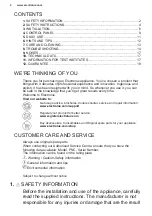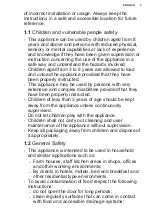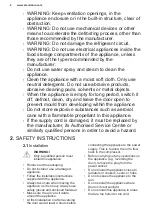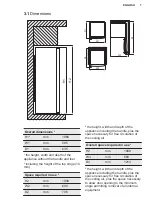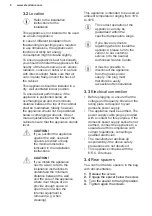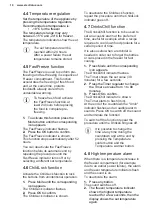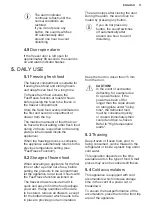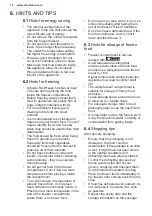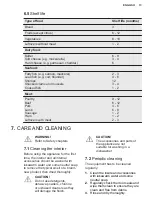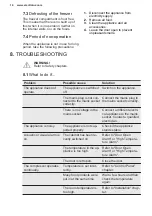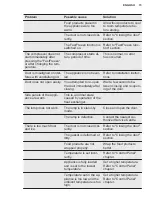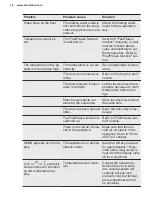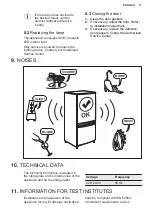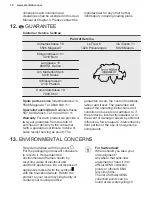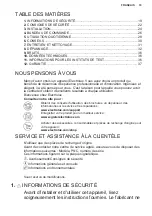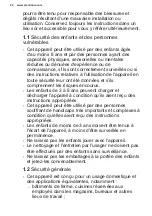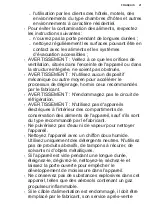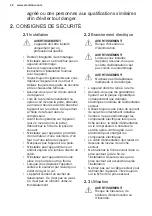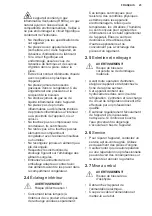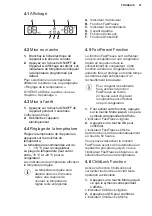
6. HINTS AND TIPS
6.1 Hints for energy saving
• The internal configuration of the
appliance is the one that ensures the
most efficient use of energy.
• Do not remove the cold accumulators
from the freezer basket.
• Do not open the door frequently or
leave it open longer than necessary.
• The colder the temperature setting,
the higher the energy consumption.
• Ensure a good ventilation. Do not
cover the ventilation grilles or holes.
• Make sure that food products inside
the appliance allow air circulation
through dedicated holes in the rear
interior of the appliance.
6.2 Hints for freezing
• Activate FastFreeze function at least
24 hours before placing the food
inside the freezer compartment.
• Before freezing wrap and seal fresh
food in: aluminium foil, plastic film or
bags, airtight containers with lid.
• For more efficient freezing and
thawing divide food into small
portions.
• It is recommended to put labels and
dates on all your frozen food. This will
help to identify foods and to know
when they should be used before their
deterioration.
• The food should be fresh when being
frozen to preserve good quality.
Especially fruits and vegetables
should be frozen after the harvest to
preserve all of their nutrients.
• Do not freeze bottles or cans with
liquids, in particular drinks containing
carbon dioxide - they may explode
during freezing.
• Do not put hot food in the freezer
compartment. Cool it down at room
temperature before placing it inside
the compartment.
• To avoid increase in temperature of
already frozen food, do not place
fresh unfrozen food directly next to it.
Place food at room temperature in the
part of the freezer compartment
where there is no frozen food.
• Do not eat ice cubes, water ices or ice
lollies immediately after taking them
out of the freezer. Risk of frostbites.
• Do not re-freeze defrosted food. If the
food has defrosted, cook it, cool it
down and then freeze it.
6.3 Hints for storage of frozen
food
• Freezer compartment is the one
marked with
.
• Good temperature setting that
ensures preservation of frozen food
products is a temperature less than or
equal to -18°C.
Higher temperature setting inside the
appliance may lead to shorter shelf
life.
• The whole freezer compartment is
suitable for storage of frozen food
products.
• Leave enough space around the food
to allow air to circulate freely.
• For adequate storage refer to food
packaging label to see the shelf life of
food.
• It is important to wrap the food in such
a way that prevents water, humidity or
condensation from getting inside.
6.4 Shopping tips
After grocery shopping:
• Ensure that the packaging is not
damaged - the food could be
deteriorated. If the package is swollen
or wet, it might have not been stored
in the optimal conditions and
defrosting may have already started.
• To limit the defrosting process buy
frozen goods at the end of your
grocery shopping and transport them
in a thermal and insulated cool bag.
• Place the frozen foods immediately in
the freezer after coming back from the
shop.
• If food has defrosted even partially, do
not re-freeze it. Consume it as soon
as possible.
• Respect the expiry date and the
storage information on the package.
www.electrolux.com
12
Содержание SG232NEEV
Страница 76: ...www electrolux com shop 280159077 A 072021 ...


